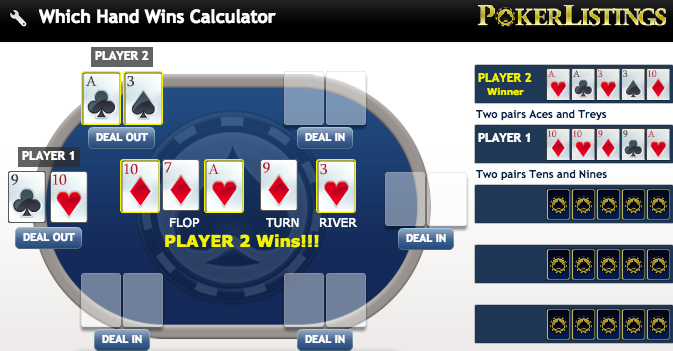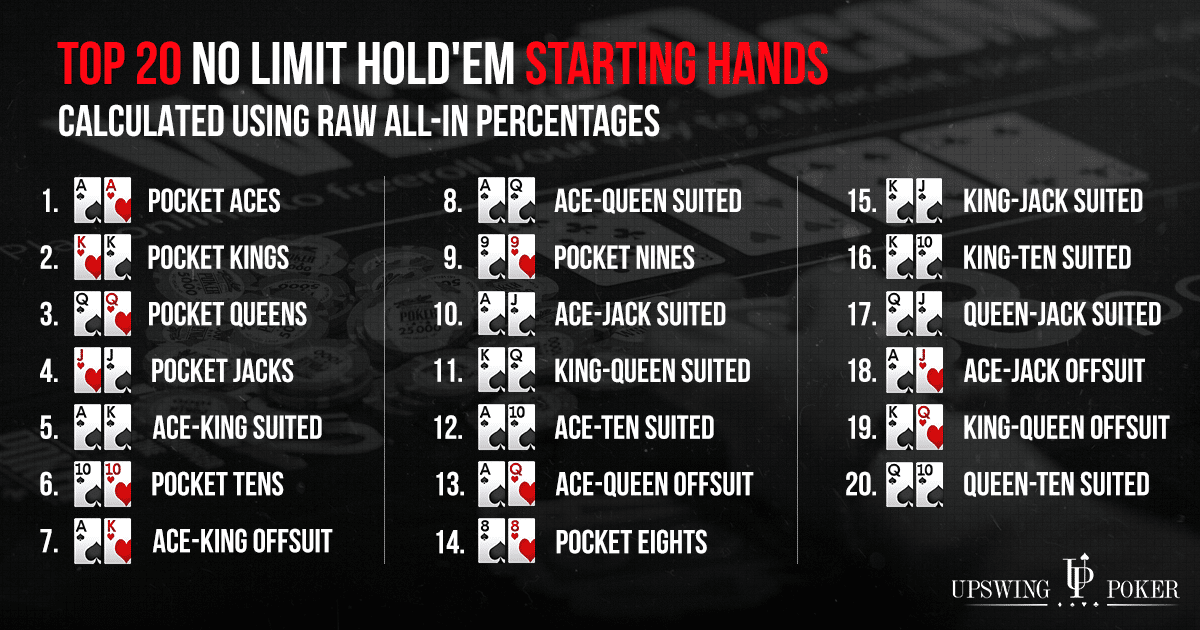A Straight In Texas Holdem
Straight draws are strong draws in Limit Texas Hold'em.

When you flop a straight draw it's either going to be an open-ended using both your hole cards, open-ended using one of your hole cards or a gut-shot straight draw. The way you play your straight draw will depend on this.
With an open ended-straight draw you have eight outs to improve to a straight. When you flop an open-ended straight draw you have approximately 2.2-1 (31.5%) against improving on the turn and river combined.
The most usual kind of poker is “high poker” where aces are always high, except the ace can optionally be low for the purpose of making a straight (that is, A-2-3-4-5 is a straight, and so is 10-J-Q-K-A). Odds of Making a Straight on the Flop. Flopping a Straight is Hold’em is not overall that likely. Naturally, it depends on the type of starting hand we have. Odds of flopping a Straight with any starting hand = 0.39%. Odds of flopping a Straight with a connector between 54 and JT = 1.29%. Odds of flopping a Straight with any connector = 1.04%. Straight Flush A straight flush is a straight and a flush that isn’t ace high. Straight flushes can be anywhere from king high down to five high.
Your hand is stronger if it has additional value like a pair and/or overcards, back-door flush potential and so forth. For example, you hold the A♠ 4♠ on a flop with the 6♦ 5♠ 3♥ giving an open-ended straight draw (8 outs), an overcard (3 outs) and a back-door flush draw (1 out).
This flop gives you 12 outs in total (45%) for improving to at least a pair. Or you hold the J♠ T♠ on a flop with the 9♣ 8♠ 3♦, giving you and an open-ended straight draw (8 outs), two overcards (6 outs) and a back-door flush draw (1 out).
This flop gives you 15 outs in total (54.1% on the turn and river combined), but you'd only feel really comfortable with the hand in case you make the straight. Nonetheless, it has additional value.
To Draw or Not to Draw in Limit Holdem?
When you flop a straight draw you want the flop to come down rainbow. Whenever the flop is two-suited you'll have to discard two outs for the flush cards.
If the flop is two-suited and there is heavy action on the flop you should fold your straight-draw, because of the likelihood your opponents are holding sets, two pairs and flush draws.
Most of the times when you flop an open-ended straight draw on a rainbow flop you'll have correct pot odds to draw. But there are a few exceptions to consider:
- The flop comes with a pair and there is heavy action on the flop. When the board pairs it much easier for your opponents to make full houses.
- You are heads-up and don't have a pair or two overcards to the flop. The pot won't be giving you sufficient odds to call. It might be worth to try for a semi-bluff in this situation, but don't check and call all the way to the river.
Whenever you draw to an open-ended straight make sure that you are not drawing to the low end of the straight. For example, you're holding 5♠ 4♠ and the flop is J♠ 7♥ 6♣, giving you an open-ended straight draw.
This straight draw should be played like a gut-shot straight draw (4 outs) since you would only feel comfortable with the hand in case a three hits.
Open-Ended Straight Draw Using Only One Card from Your Hand
These types of flops are not as strong as the ones where you use both your hole cards. The reason for this is that the straight possibility is so obvious to you opponents and someone might already have flopped a straight.

There is also a much higher probability that you'll end up splitting the pot if you make the straight. The action also dries up when the fourth straight card hits and it might be difficult to get paid off even though you might hold the best hand.
Gut-Shot Straight Draw
This type of draw has only one card that gives you a straight, making 4 outs in total. This is approximately 11-1 against improving on the turn.
This is a hand that is pretty strong when it has additional values like two overcards. Holding K♠ Q♠ on a flop of T♠ 9♣ 6♦ is a pretty strong draw - the gut-shot straight draw to the nuts (4 outs), two overcards (6 outs, but beware of a possible straight in case a queen hits) and back door flush potential (1 out).
Heads-up this hand should be played aggressively.
Generally you are not getting sufficient pot odds to draw with only a gut-shot straight draw unless the pot has been raised before the flop. But if there are many callers before the flop, on the flop it is usually correct to draw but only do this if you are drawing to the nut straight.
For example you raise with an AQs and get four callers, the flop comes down K-T-3 (10 small bets in the pot).
You check, the opponent sitting behind you bets and there are a few callers in between you and the bettor. In this case the pot odds warrant a call in the hopes of hitting a jack that would give you the nut-straight.
You are approximately 11-1 against on improving on the turn (8.7%), but the pot is big enough to make this call correct. When you are drawing to gut-shot straights you should almost always fold if there is a risk of someone raising behind you.
Texas Holdem Straight Rules
Poker can be a fun card game for the family, or a serious competitive game in which the steaks can be so enormous, even selling your house wouldn’t cover the costs.
There are many variations of poker, with Texas Hold ‘Em being the most popular worldwide.

Below are a whole bunch of poker facts and statistics which help you understand the chances of wining and the odds of getting the cards you want.
Did You Know?
A pocket pair is cards of the same rank, which means if your two cards have the same number, from 2-2 all the way up to A-A, this is called a pocket pair.
- The odds of receiving any pocket pair is 5.9% which is 16 to 1. These are also the same odds of receiving a pocket pair of 2’s.
- The odds of receiving a specific pocket pair: 0.45% or 220 to 1 These are the same odds for receiving a pocket pair of A’s.
- The odds of receiving a pocket pair of A’s twice in a row is 0.002047% or 48,840 to 1.
- The odds of receiving a pocket pair of K’s is 0.9% which is 220 to 1.
- The odds of receiving a pocket pair of Q’s is 1.4% which is 73 to 1.
- The odds of receiving a pocket pair of J’s is 1.8% which is 54 to 1.
- The odds of receiving a pocket pair of 10’s is 2.3% which is 43 to 1.
- The odds of receiving a pocket pair of 9’s is 2.7% which is 36 to 1.
- The odds of receiving a pocket pair of 8’s is 3.2 which is 31 to 1.
- The odds of receiving a pocket pair of 7’s is 3.6% which is 27 to 1.
- The odds of receiving a pocket pair of 6’s is 4.1% which is 24 to 1.
- The odds of receiving a pocket pair of 5’s is 4.5% which is 21 to 1.
- The odds of receiving a pocket pair of 4’s is 5.0% which is 19 to 1.
- The odds of receiving a pocket pair of 3’s is 5.4% which is 17 to 1.
Poker Fast Facts
The total number of possible royal flush hands in a standard 52 card deck is 4.
And the odds of making a royal flush is 649,739 to 1.
This is correct assuming that every game plays to the river.
In poker terms, the river is the name for the fifth card dealt, face-up on the board.
In total, there are 2,598,960 possible poker hands with 52 cards.
Ultimate Texas Hold'em Rules
The odds of getting four of a kind in Texas Hold ‘Em is 4164 to 1.
Casinos normally change decks after 15 minutes of steady play, so that the cards can always be fresh and unmarked, as many professional players would be able to remember the certain markings on cards and use that to their advantage.

Is Jqka 2 A Straight In Texas Holdem
This is only a basic overview of poker odds, there are many calculators online that can help solve the odds of getting certain hands, depending on what stage of the game you’re at, what cards you currently hold and how many people are playing.
Now you are familiar with these odds, you can use them to your advantage for a better poker strategy when you finally decided to play a tournament.
In Texas Hold-Em Poker the odds of making a royal flush hand is only 649,739 to 1.